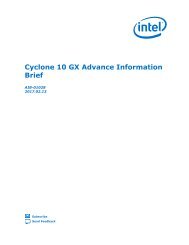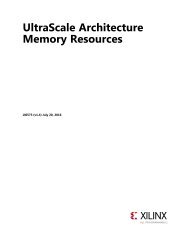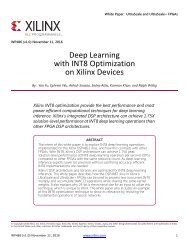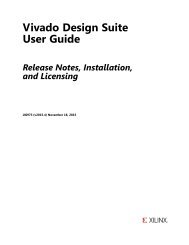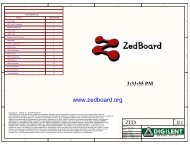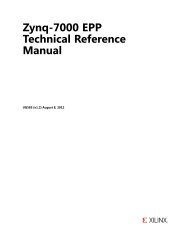UltraScale Architecture Memory Resources
ug573-ultrascale-memory-resources
ug573-ultrascale-memory-resources
You also want an ePaper? Increase the reach of your titles
YUMPU automatically turns print PDFs into web optimized ePapers that Google loves.
Chapter 3<br />
Built-in Error Correction<br />
Overview<br />
The RAMB36E2 in simple dual-port mode can be configured as a single 512 x 64 RAM with<br />
built-in Hamming code error correction using the extra eight bits in the 72-bit wide RAM.<br />
This operation is transparent.<br />
Eight protection bits (ECCPARITY) are generated during each write operation and stored<br />
with the 64-bit data into the memory. These ECCPARITY bits are used during each read<br />
operation to correct any single-bit error, or to detect (but not correct) any double-bit error.<br />
The ECCPARITY bits are written into the memory and output to the FPGA logic at each rising<br />
edge of the WRCLK. There are no optional output registers available on the ECCPARITY<br />
output bits.<br />
During each read operation, 72 bits of data (64 bits of data and 8 bits of parity) are read<br />
from the memory and fed into the ECC decoder. The ECC decoder generates two status<br />
outputs (SBITERR and DBITERR) that are used to indicate the three possible read results: No<br />
error, single-bit error corrected, and double-bit error detected. In the standard ECC mode,<br />
the read operation does not correct the error in the memory array, it only presents<br />
corrected data on DOUT. To improve F MAX , optional registers controlled by the DO_REG<br />
attribute are available for data output (DOUT), SBITERR, and DBITERR. This is similar to the<br />
optional registers in the block RAM. For further F MAX improvements, an additional ECC<br />
pipeline stage is available.<br />
The ECC configuration option is available with a 36 Kb block RAM (RAMB36E2) in simple<br />
dual-port mode 72-bit width (64/8) (SDP) or a 36 Kb FIFO (FIFO36E2) in 72-bit width. Both<br />
read and write width must be 72 bits. The RAMB36E2 has the capability to inject errors. The<br />
RAMB36E2 has the ability to read back the address where the current data read out is<br />
stored. This feature better supports repairing a bit error or invalidating the content of that<br />
address for future access. The FIFO36E2 supports standard ECC mode with both the<br />
WRITE_WIDTH and READ_WIDTH set to 72 and has error-injection capability. FIFO36E2 does<br />
not output the address location being read.<br />
The block RAM ECC also supports READ_FIRST, WRITE_FIRST, and NO_CHANGE modes in<br />
identical fashion to the SDP usage model.<br />
<strong>UltraScale</strong> <strong>Architecture</strong> <strong>Memory</strong> <strong>Resources</strong> www.xilinx.com<br />
Send Feedback<br />
82<br />
UG573 (v1.2) February 24, 2015



